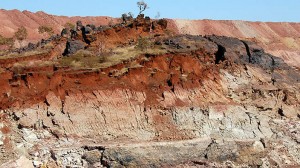NT miners fined for desecrating Aboriginal site
The Darwin Magistrates Court ruled that OM Manganese damaged the site known in English as Two Women Sitting Down, at Bootu Creek, north of Tennant Creek. The company was fined $150,000 – the biggest-ever penalty levied under the Northern Territory Sacred Sites Act.
170 km North of Tennant Creek lies Bootu Creek, home to the Kunapa people. A sacred site there, called Two Women Sitting Down, once told a dreaming story about a marsupial rat and a bandicoot that had a fight over bush tucker.
Custodian Gina Smith says the site had a deeply personal meaning for her.
“The two women were Namakile which is my mother’s skin, and Napanunga which is the skin name for my daughter as well as my great grandmother whose skin name is Napanunga too. So it’s very important to us because you have to look after it like it’s you own mother or your own daughter or your own great grandmother.”
The site was part of a dreaming songline, which, like a railway line, formed a string of sacred sites, each representing a different station along the way. Now it lies in ruins and custodian Gina Smith says it can’t be replaced.
The destruction of the site, back in 2011, was due to drill and blast mining nearby by OM Manganese, the subsidiary of Singapore-based OM Holdings Ltd, which was mining for the rich manganese ore found in the area.The company had received permission to mine in the area from the Aboriginal Areas Protection Authority of the Northern Territory, as long as the sacred site was not harmed.
In March that year, a prominent stone feature of the site called the Horses head was showing damage, but it was unknown then whether it was related to the blasting going on nearby. In July, cracking appeared, then a large part of the site fell into the open cut pit. Mining halted immediately but the damage was done.
OM Holdings CEO Peter Toth refutes claims that the damage was a result of cost-cutting. However, he says he recognises that major mistakes were made at the time.
“We had undertaken an assessment of how to mine that area in close proximity to the sacred site. Now we’ve made two mistakes in the process. We’ve under-estimated the geological conditions of the area and also made mistakes in terms of the pit design and the slope geometry and the blasting procedure and these two things have effectively resulted in the damage.”
The damage was brought to the attention of the Aboriginal Areas Protection Authority, sparking off two year legal proceedings. Three counts were brought against OM Manganese: The first charge of desecration to the stone pillar, the second of damage to the sacred site due to the collapse. The third charge was of desecration of the sacred site due to the company continuing to mine after the initial collapse.
The company has been found guilty of the first two charges and fined over $150,000.
CEO of the Aboriginal Areas Protection Authority, Dr Ben Scambary, says it is a landmark case. “It’s landmark because desecration has been contested and won in Australia. It’s also the first time that desecration has been contested and won under the NT Aboriginal Sacred Sites Act. It also represents the biggest fine ever levied under the Northern Territory Sacred Sites Act.”
However Dr Scambary says the damage done cannot be measured in terms of monetary value. “The decision doesn’t relieve the anguish of the custodians who have been left an enduring legacy through the devastation of their sacred site and that entails a range of social consequences that they have to deal with. This sacred site represents not just damage to a particular sacred site but it also in a genuine loss of heritage values for the whole country.”
The case is being taken as a warning for companies mining near sacred sites. However, for Gina Smith and the Kunapa community, the end of the case is a relief but nothing can restore the loss of their culture.
“It will always be a sad time when we sing around that area and unable to take our children out there and our families or extended families. It will never be the same.”
(Transcript from World News Australia Radio), ByLaura Murphy-Oates
